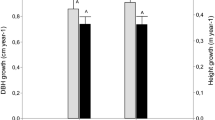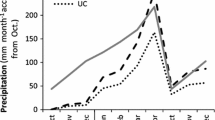Abstract
Pinus pinea is native to the Mediterranean basin, being an interesting species due to its high-value edible pine nuts (prices between €20 and €45 kg−1), its ability to adapt to differing environmental conditions and its relative fast growth in Chile. The species was introduced to Chile more than one century ago by European migrants, who used it for dune stabilization, soil improvement and livestock shading. Agroforestry systems including stone pine and agricultural crops (forage oat and potatoes) and sheep grazing for mutton production were tested in two experimental plots located in El Carmen, Biobío region. The plots were evaluated during 5 years after planting. Crop yields were lower than the region average, reaching nearly 60% of national average yields of forage oat and 66–86% of potato. Forage production in these plots was not enough to sustain permanent grazing; however, sheep grazing in regulated periods contributes to mutton production. Grazing reduces weed and shrub growth, fire risk and the cost of periodic mechanical cleaning. Stone pine annual growth in height and diameter at collar height (ground level) were on average 50 and 2.5 cm, respectively, and was found to be a suitable species for agroforestry systems. Net present value was almost seven times higher in the agroforestry system than in pure stone pine plantations; therefore, this system can contribute to the local and national economy.



Similar content being viewed by others
References
Agrimi M, Ciancio O (1994) Italian Stone pine (Il pino domestico) (Pinus pinea L.). FAO Silva Mediterranea, Larnaca
Anderson GW, Moore RW, Jenkins PJ (1988) The integration of pasture, livestock and widely-spaced pine in South West Western Australia. Agroforest Syst 6:195–211
Arthur-Worsop, MJ (1984) An economic evaluation of agroforestry: the national viewpoint. In: Proceedings of a technical workshop on agroforestry. Ministry of Agriculture and Fisheries, Wellington, New Zealand, pp 61–70
Badal E (2001) La recolección de piñas durante la prehistoria en la Cueva de Nerja (Málaga). In: Villaverde V (ed) De neandertales a cromañones-el inicio del poblamiento humano en las tierras valencianas. Universidad de Valencia, Spain, pp 101–104 (in Spanish)
Balandier P, Dupraz C (1999) Growth of widely spaced trees. A case study from young agroforestry plantations in France. Agroforest Syst 43:151–167
BBC (2014) Eva Mueller: UN urges action on forest diversity. http://m.bbc.com/news/science-environment-27963330. Accessed 23 June 2014
Buresti E, Mori P, Ravagni S (2001) Arboricoltura da legno con il ciliegio: ridurre i rischi adottando la doppia pianta. Sherwood 73:11–16 (in Italian)
Chifflot V, Bertoni G, Cabanettes A, Gavaland A (2005) Beneficial effects of intercropping on the growth and Nitrogen status of young wild cherry and hybrid walnut trees. Agroforest Syst 66(1):13–26
Claro M (2009) Pequeñas explotaciones ovinas en la zona sur de Chile. http://es.slideshare.net/miclaro/pequeas-explotaciones-ovina-zona-sur-de-chile?related=1 Accessed 12 Sept 2015 (in Spanish)
Crawford M (1995) Nut pines. Yearbook, West Australian Nut and Tree Crops Association 19: 56–66
Cruz C (2008) La cascara de piñón ahorra el 30% más que el gas. http://www.elnortedecastilla.es/20080227/palencia/cascara-pinon-ahorra-20080227.html. Accessed 12 Aug 2011 (in Spanish)
Day JK, Pérez DM (2013) Reducing uncertainty and risk through forest management planning in British Columbia. For Ecol Manag 300:117–124
Di Rienzo JA, Casanoves F, Balzarini MG, Gonzalez L, Tablada M, Robledo CW (2015) InfoStat version 2015. Grupo InfoStat, FCA, Universidad Nacional de Córdoba, Argentina. http://www.infostat.com.ar
Dube F, Thevathasan NV, Stolpe N, Espinosa M, Zagal E, Gordon AM (2013) Selected carbon fluxes in Pinus ponderosa-based silvopastoral systems, exotic plantations and natural pastures on volcanic soils in the Chilean Patagonia. Agroforest Syst 87(3):525–542
Eichhorn MP, Paris P, Hderzog F, Incoll LD, Liagre F, Mantzanas K, Mayus M, Moreno G, Papanastasis VP, Pilbeam DJ, Pisanelli A, Dupraz C (2006) Silvoarable systems in Europe—past, present and future prospects. Agroforest Syst 67:29–50
Garland K R, Fisher WW, Greig PJ (1984) Agroforestry in Victoria. Technical Report Series (Victoria. Dept. of Agriculture) N° 93
Gil L (1999) La transformación histórica del paisaje: la permanencia y la extinción local del pino piñonero. In: Marín F, Domingo J, Calzado A (eds) Los montes y su historia, una perspectiva política, económica y social. Spain, pp. 151–185 (in Spanish)
Goor A, Barney C (1976) Forest tree planting in arid zones, 2nd edn. The Ronald Press Company, New York, US, p 504
Haltenhoff H (2006) Silvicultura Preventiva, para la prevención de incendios forestales en plantaciones forestales. Documento de Trabajo Nº 452, 2º edition. Corporación Nacional Forestal. Santiago, Chile
INE (2014a) Variables de estado del medio ambiente [Online] http://www.ine.cl/canales/chile_estadistico. Accessed 29 April 2014 (in Spanish)
INE (2014b) Estimación de superficie, producción y rendimientos de cultivos anuales según región. Año agrícola 2013-2014. http://www.ine.cl/canales/menu/publicaciones/calendario_de_publicaciones/xls/tabulados_cosecha_ca_2013_2014.xls. Accessed 13 Feb 2017 (in Spanish)
Loewe MV, Delard RC (2012) Un nuevo cultivo para Chile, el Pino Piñonero (Pinus pinea L.). INFOR-CORFO, Santiago, Chile (in Spanish)
Loewe MV, Delard RC (2016) Producción de piñón mediterráneo (Pinus pinea L.). Manual N° 48. INFOR (in Spanish)
Loewe MV, González M (2003) Sicomoro, grevillea, roble rojo americano, pino piñonero, castaño, ruil y cerezo americano, alternativas para producir madera de alto valor. INFOR-FIA, Santiago, Chile (in Spanish)
Loewe MV, González OM (2006) Sistemas agroforestales con nogal común (Juglans regia), experiencias exitosas para zonas templadas. In: IV Agroforestry Latinoamerican Congress. Cuba (in Spanish)
Loewe MV, González M (2007) Pino piñonero: el potencial de su madera y fruto. Chile For 334:49–53 (in Spanish)
Loewe MV, Venegas V (2005) Escenarios y Desafíos del Desarrollo Forestal Chileno. In: Barrera A, Venegas V, Tomic T, Rojas H (eds) Economía del Conocimiento y Nueva Agricultura, pp. 265–289 (in Spanish)
Loewe MV, Vargas V, Ruiz JM, Alvarez A, Lobo QF (2015a) Creation and implementation of a certification system for insurability and fire risk classification for forest plantations. In: Proceedings of the large fires conference held in Missoula in May of 2014. USDA Forest Service proceedings RMRS-P-73, pp 141–149
Loewe MV, Delard RC, Balzarini M, Álvarez CA, Navarro-Cerrillo RM (2015b) Impact of climate and management variables on stone pine (Pinus pinea L.) growing in Chile. Agric For Meteorol 214–215:106–116
Loewe MV, Balzarini M, Álvarez A, Delard C, Navarro-Cerrillo RM (2016) Fruit productivity of Stone pine (Pinus pinea L.) along a climatic gradient in Chile. Agric For Meteorol 223:203–216. https://doi.org/10.1016/j.agrformet.2016.04.011
Mancilla-Leyton JM, Sánchez-Lineros V, Vicente AM (2013) Influence of grazing on the decomposition of Pinus pinea L. needles in a silvopastoral system in Doñana, Spain. Plant Soil 373:173–181
Mutke S, Calama R, Gordo J, Gil L (2007) El uso del pino piñonero como especie de frutal en sistemas agroforestales de secano. Cuadernos de la Sociedad Española de Ciencias Forestales 22:137–142
Pardini A, Nori M (2011) Agro-silvo-pastoral systems in Italy: integration and diversification. Pastoralism 1(1):26
Peña E, Pedernera P (2004) Silvicultura preventiva para combatir incendios forestales. Chile For 302:12–14 (in Spanish)
Prada MA, Gordo J, De Miguel J, Mutke S, Catalán G, Iglesias S, Gil L (1997) Las regiones de procedencia de Pinus pinea L. en España. Organismo Autónomo de Parques Naturales, Madrid, Spain (in Spanish)
Pretzsch H, del Río M, Schütze G, Ammer Ch, Annighöfer P, Avdagic A, Barbeito I, Bielak K, Brazaitis G, Coll L, Drössler L, Fabrika M, Forrester DI, Kurylyak V, Löf M, Lombardi F, Matovic B, Mohren F, Motta R, den Ouden J, Pach M, Ponette Q, Skrzyszewski J, Sramek V, Sterba H, Svoboda M, Verheyen K, Zlatanov T, Bravo-Oviedo A (2016) Mixing of Scots pine (Pinus sylvestris L.) and European beech (Fagus sylvatica L.) enhances structural heterogeneity, and the effect increases with water availability. For Ecol Manag 373:149–166
Reisner Y, De Filippi R, Herzog F, Palma J (2007) Target regions for silvoarable agroforestry in Europe. Ecol Eng 29:401–418
Seidel D, Leuschner C, Scherber C, Beyer F, Wommelsdorf T, Cashman MJ, Fehrmann L (2013) The relationship between tree species richness, canopy space exploration and productivity in a temperate broad-leaf mixed forest. For Ecol Manag 310:366–374
Soto D, Gysling J, Loewe V (2008) Antecedentes del Mercado Internacional de Piñones de Pino. Ciencia e Investigación Forestal 14(3):599–623 (in Spanish)
Sotomayor A, Barros S (eds) (2016) Los Sistemas Agroforestales en Chile. Instituto Forestal, Chile, p 456
USDA (2006) Wildland Fire and Fuels Research and Development Strategic Plan: Meeting the Needs of the Present, Anticipating the Needs of the Future. U.S. Department of Agriculture, Forest Service, Research and Development, Washington, DC, p 50
Acknowledgements
The study was conducted as part of the R&D project “Development of techniques for producing stone pine (Pinus pinea L.) pine nuts, an attractive commercial option for Chile” (D11I1134), funded by FONDEF (CONICYT), in execution between 2012 and 2016. Authors especially thank Mr. Lorenzo Campos, the landowner who has actively collaborated with system establishment and management.
Author information
Authors and Affiliations
Corresponding author
Rights and permissions
About this article
Cite this article
Loewe, V., Delard, C. Stone pine (Pinus pinea L.): an interesting species for agroforestry in Chile. Agroforest Syst 93, 703–713 (2019). https://doi.org/10.1007/s10457-017-0166-6
Received:
Accepted:
Published:
Issue Date:
DOI: https://doi.org/10.1007/s10457-017-0166-6




